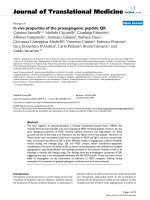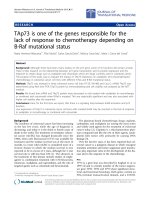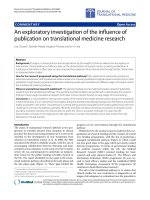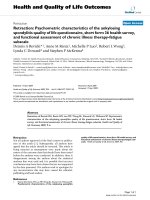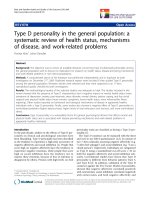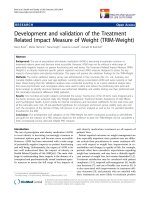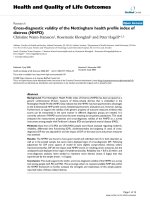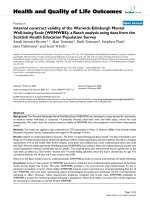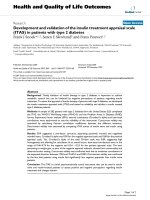báo cáo hóa học:" Rapidly destructive osteoarthritis of the hip joint: a case series" pdf
Bạn đang xem bản rút gọn của tài liệu. Xem và tải ngay bản đầy đủ của tài liệu tại đây (325.61 KB, 6 trang )
BioMed Central
Page 1 of 6
(page number not for citation purposes)
Journal of Orthopaedic Surgery and
Research
Open Access
Research article
Rapidly destructive osteoarthritis of the hip joint: a case series
Sameer Batra*
1
, Meenakshi Batra
2
, A McMurtrie
3
and AK Sinha
3
Address:
1
Division of spine surgery, Department Of Orthopaedics, Llandough Hospital, Penarth, UK,
2
Department of pathology, Wrexham Maelor
hospital, Wrexham, UK and
3
Department Of Orthopaedics, Gwynedd Hospital, North West Wales NHS Trust, Bangor, Gwynedd, UK
Email: Sameer Batra* - ; Meenakshi Batra - ; A McMurtrie - a.mcmurtrie@nww-
tr.wales.nhs.uk; AK Sinha -
* Corresponding author
Abstract
Background: Rapidly destructive arthrosis of the hip is a rare and incompletely understood
disorder with scarce literature about variations in natural history within a population.
Methods: A series of cases from North Wales with rapid progressive joint destruction and
extensive subchondral bone loss in the femoral head and acetabulum are presented. Radiographic
findings mimicked those of other disorders such as septic arthritis, rheumatoid and seronegative
arthritis, primary osteonecrosis with secondary osteoarthritis, or neuropathic osteoarthropathy,
but none of the patients had clinical, pathologic, or laboratory evidence of these entities.
Results: Rapid progression of hip pain and disability was a consistent clinical feature. The average
duration of symptoms was 1.4 years. Radiographs obtained at various intervals before surgery
(average 14 months) in 18 patients documented rapid hip destruction, involvement being unilateral
in 13 cases. All patients underwent total hip arthroplasty, and osteoarthritis was confirmed at
pathologic examination.
Conclusion: The authors postulate that these cases represent an uncommon subset of
osteoarthritis and regular review, both clinically and radiologically, are required to assess speed of
progression and prevent rapid loss of bone stock without the surgeon being aware. These cases
are unsuitable for being placed on long waiting list due to technical difficulties in delayed surgery
and compromised outcome following surgery.
Background
Rapidly progressive hip disease (RDHD) is a rare syn-
drome of unknown etiology and distinct from ischaemic
necrosis of the femoral head, resulting in rapid deteriora-
tion of both the femoral and acetabular aspects of the hip
joint with disappearance of the femoral head as first
reported by Forestier [1]. The natural history of hip oste-
oarthrosis has been extensively documented [1-3] with
well known inter-racial variations [4]. Little, however, has
been written about variation in natural history within a
population and only scant mention of discrete subgroup
of this type appears in the English language journals, with
studies originating mainly in continental Europe.
Attempts to characterise this disorder are limited to case
reports where inconsistent associations have been made.
The senior author (AKS) came across a series of cases from
North Wales with this rapidly progressive presentation of
osteoarthritis and became concerned that these patients
may be losing up to 15 mm of bone stock annually while
Published: 11 January 2008
Journal of Orthopaedic Surgery and Research 2008, 3:3 doi:10.1186/1749-799X-3-3
Received: 1 May 2007
Accepted: 11 January 2008
This article is available from: />© 2008 Batra et al; licensee BioMed Central Ltd.
This is an Open Access article distributed under the terms of the Creative Commons Attribution License ( />),
which permits unrestricted use, distribution, and reproduction in any medium, provided the original work is properly cited.
Journal of Orthopaedic Surgery and Research 2008, 3:3 />Page 2 of 6
(page number not for citation purposes)
on the waiting list. Failure to act on rapidly worsening hip
arthrosis is well recognised to compromise the success of
surgery and is clearly undesirable, hence making these
unsuitable for being placed on long waiting lists. Moreo-
ver, if such cases can be identified, it should be made pos-
sible to offer them a priority for treatment.
We hereby present this series of cases from a population
group from North Wales that we believe represent a subset
of osteoarthritis that has been recognized in the literature
as rapid destructive osteoarthritis (RDO) [1-5].
We highlight the importance of repeat radiographs for
patients with continued severe hip pain without an appar-
ent cause. The purpose of our report is to make clinicians
faced with a diagnostic dilemma in general practice, rheu-
matology or orthopaedic clinics, aware of the condition
and present the clinical, radiographic and pathologic fea-
tures of this unique hip disorder that can be confused
radiographically with other more well recognised destruc-
tive hip arthropathies.
Methods
A retrospective review of patients with a clinical profile
and serial radiographs suggestive of a rapidly progressive
hip disease was undertaken. The search revealed 145
patients who received I56 primary implants. Hospital
notes from all cases were studied and patients with
inflammatory arthritis, primary osteonecrosis, renal
osteodystrophy and trauma were identified and excluded,
leaving 115 patients with primary osteoarthritis including
this subset. This revealed 18 patients (incidence of RDHD
is about 15.7%) who met our criteria for RDHD in the
period between May 2004 and May 2006 carefully exclud-
ing inflammatory arthritis, primary osteonecrosis, renal
osteodystrophy and trauma. A retrospective analysis of
clinical and radiographic records was performed. When
available, serial radiographs of the hips were similarly
evaluated, and the time between the last normal radio-
graph and that showing most severe destruction was
recorded. The criteria for RDHD were a clinical history of
hip pain of 1–6 months duration, a radiologic appearance
of rapidly progressive atrophic bone destruction involving
the femoral head and the acetabulum, the absence of clin-
ical or laboratory evidence of infectious, neurologic, met-
abolic, endocrinologic, or inflammatory disorders. This
excluded patients who were found to have rheumatoid
arthritis, primary avascular necrosis, renal osteodystro-
phy, abnormalities of calcium metabolism or where
trauma was suspected of having played a part in the hip
disease. Septic arthritis was excluded on the basis of
results of joint aspiration and/or clinical and laboratory
examinations. Neurologic disease as well as a history of
steroid medication was assessed. Ischemic necrosis was
excluded on the basis of radiographic appearance of
atrophic destruction and failure to identify the usual
stages of osteonecrosis on serial radiographs.
Finally, the surgical findings at joint replacement or
biopsy were recorded in cases in which histologic exami-
nation had been performed. These data were reviewed.
Results
The study group contained 16 women (89%) and 2 males
(11%), average age 68.8 years (range, 47–81 years). The
duration of symptoms ranged from 6 months to 3 years
(mean, 1.4 years). All patients presented with hip pain. 14
patients (78%) suffered pain for two years or less. None of
these18 cases had evidence of rheumatoid arthritis, pri-
mary avascular necrosis, renal osteodystrophy, abnormal-
ities of calcium metabolism vascular history, alcoholism,
and there was no relevant occupational or pharmacologi-
cal history. None of the patients underwent systemic ster-
oid administration or injection of steroids to the affected
joint, and none had a history of alcohol abuse. The mean
time for the radiographic appearance of joint destruction
after a negative radiograph was 14 months (range, 4
months to 2 years). There were at least four hips with dra-
matic destruction over a period of 6 months. (Two exam-
ples illustrated in Figures 1, 2, 3, 4, 5)
The femoral heads were small, and in most cases, the
weight-bearing surface was flat. Resected femoral heads
showed disappearance of articular cartilage in the weight-
bearing area and a large part of the subchondral bone was
destroyed. The articular surface was eroded and flattened
with some ebumation and the presence of fibrous tissues.
In cases with severe destruction, the articular surface was
totally covered by fibrous tissues.
Histology was available in 11 cases. Histologic examina-
tion failed to demonstrate evidence of acute or chronic
inflammation or any pathologic abnormality other than
severe degenerative changes. Areas of segmental
osteonecrosis were present at the subarticular region in 4
cases. Necrotic bone and bone marrow were evident. His-
tology of femoral heads failed to show the findings typical
of primary osteonecrosis, in which trabecular and marrow
necrosis (necrotic zone) is observed adjacent to viable
bone marrow (viable zone) with an intervening zone of
repair (reparative zone).
There was no evidence of sepsis in any of the specimens
analysed, and over the course of this study none of the
study group presented with evidence of deep sepsis asso-
ciated with prosthesis.
Discussion
Rapidly destructive arthrosis of the hip an uncommon
subset of osteoarthritis and was first described by Forestier
Journal of Orthopaedic Surgery and Research 2008, 3:3 />Page 3 of 6
(page number not for citation purposes)
Anteroposterior radiographs obtained in a 70-year-old woman with painful bilateral hips of 4 months durationFigure 3
Anteroposterior radiographs obtained in a 70-year-old
woman with painful bilateral hips of 4 months duration.
Anteroposterior radiographs obtained in a 67-year-old woman with painful right hipFigure 1
Anteroposterior radiographs obtained in a 67-year-old
woman with painful right hip. View obtained 3 months after
pain began reveals typical osteoarthritis
6 months later, severe flattening of the femoral head with an eccentric depression of the lateral articular surface associ-ated with superolateral subluxation, sclerosis, and subchon-dral defectsFigure 2
6 months later, severe flattening of the femoral head with an
eccentric depression of the lateral articular surface associ-
ated with superolateral subluxation, sclerosis, and subchon-
dral defects. Notice the hatchet-like appearance of the
femoral head.
3 months later reveals further worsening with prominent femoral head flattening and marked sclerosis with absence of osteophytesFigure 4
3 months later reveals further worsening with prominent
femoral head flattening and marked sclerosis with absence of
osteophytes.
Journal of Orthopaedic Surgery and Research 2008, 3:3 />Page 4 of 6
(page number not for citation purposes)
in 1957 [1] and subsequently labelled atrophic osteoar-
thritis, rapidly progressive osteoarthritis, destructive oste-
oarthritis, and Postel's osteoarthritis [2]. Lequesne
defined it as a greater than 2 mm/year rate of joint space
narrowing, i.e. loss of more than 50% of the joint space
within 1 year [5].
Over the next three decades, subsequent series and reports
emphasized the clinical, radiographic and pathologic
findings of this unusual condition. The series of cases in
our region with rapid severe progressive hip joint destruc-
tion within few months drew our attention, which we
think need to be prioritised with regard to surgical inter-
vention and are unsuitable for un-reviewed placement on
long waiting lists. This is mainly due to the intraoperative
technical difficulty due to significant acetabular bone loss;
increased blood loss during surgery coupled with
increased operating times and need for special implants
all making joint reconstruction challenging in these
patients. This is associated with compromised outcome
following surgery and researchers have indicated that
overall results and survivorship are adversely affected by
any acetabular defect, and this is certainly the main tech-
nical problem with rapidly progressive cases [6]. There is
therefore clearly a need for early diagnosis of this rapidly
destructive hip OA.
Initially, radiographs show either normal anatomy or
mild osteoarthritic changes. Follow-up radiographs in a
few months of the onset of symptoms, demonstrate
destruction of the femoral head and acetabulum with scle-
rosis, subchondral cysts, and minimal or no osteophytes.
RDHD may radiographically be confused with other dis-
ease entities such as primary osteonecrosis with secondary
arthritis, rheumatoid arthritis, neuropathic arthropathy or
septic arthritis. In most cases, however, clinical history
and radiographic findings are sufficient for excluding the
latter entities. However, the rapid progression of this dis-
ease makes it difficult to obtain sequential radiographs in
its early stages [4].
The average age at onset is greater than that of patients
with ordinary coxarthrosis with primarily unilateral
involvement, and severe pain but relatively preserved
range of motion. One characteristic of rapidly progressive
cases, however, is that they appear radiologically to be
atrophic rather than hypertrophic with an almost com-
plete absence of osteophytes [7]. They are also character-
ized by the presence of lateral disease [8,9]. Overweight,
elderly women with lateral disease and minimal osteo-
phyte formation appear to represent the group most "at
risk" [9].
The pathologic findings, however, are consistent with
osteoarthritis. Our study supports the features of RDHD
described previously in literature. The short duration of
symptoms as well as the retrospective nature of study may
explain the absence of sequential radiographs and MR
imaging in our patients. The referring clinician in primary
care may not be aware of this entity and as the patient is
already on waiting list for hip replacement, repeat radio-
graphs may not be deemed necessary. But it has to be
emphasized that patients suffering rapid deterioration
cannot reliably be picked up by questionnaire and do not
always alert the clinicians to the worsening symptoms
[10]. In addition, x-ray and pathologic progression may
approach [11], but not exactly match pain and disability
[10]. If the clinician is made aware of RDHD, the need for
extensive investigation to exclude sepsis may be obviated.
Furthermore, placement of a total joint prosthesis in a
patient with neuropathy can often lead to failure [2].
The precise pathogenesis of rapidly destructive hip oste-
oarthritis remains unclear. Direct drug toxicity and nons-
teroidal anti-inflammatory drugs were first incriminated
but their contributory effect was subsequently challenged
[2,12]. Subchondral bone ischemia and cell necrosis
recently have been emphasized as major factors in the
development of RDHD by Mitrovic and Riera [13]. Path-
ologically, many investigators have reported that osteo-
clast count is significantly greater in active areas of the hip
in RDHD than in osteoarthritic patients along with vascu-
lar-rich granulation, suggest ing that vascularity is an
important factor in the osteolysis and destruction of the
bone [14,15]. Others have demonstrated elevated levels of
interleukin-6 (IL-6), IL-1β in the joint fluid of affected
patients as well as increased secretion of matrix metallo-
proteinases(MMP) by fibroblasts from the affected syn-
ovium and subchondral cysts [16,17]. Although
4 months later, severe destruction of femoral heads on both sidesFigure 5
4 months later, severe destruction of femoral heads on both
sides.
Journal of Orthopaedic Surgery and Research 2008, 3:3 />Page 5 of 6
(page number not for citation purposes)
implicated as a causative factor, no genetic analysis such
as that using human leukocyte antigen for rapidly destruc-
tive arthropathy has been reported.
Histologically, partial necrosis of the subchondral bone
has been recognized, but it is unknown whether
osteonecrosis is the primary cause of RDHD or secondary
to degenerative changes because it is difficult to determine
the pathogenesis from late stage specimens obtained at
total hip arthroplasty. Histologically, RDHD has elements
characteristic of ordinary coxarthrosis or idiopathic avas-
cular necrosis (AVN) of the femoral head (or both):
Destruction of the femoral head and the acetabulum is
severe and widespread, articular cartilage disappears com-
pletely, and the synovial membrane is hypervasculated
and slightly inflamed. However, no new bone formation
has been observed and no osteophytes have been found,
which are typical of ordinary coxarthrosis. Findings such
as more rapid and more pervasive invasion, lack of a line
of demarcation between necrotic and healthy tissue, and
lack of a recurrent necrosis differentiate the disease from
idiopathic AVN of the femoral head. Immunohistochem-
ical analysis of articular cartilage and the synovium also
demonstrates a different pattern from that of idiopathic
AVN and coxarthrosis. However, the pattern is similar to
that seen in rheumatoid arthritis. This immunologic
response of the articular cartilage explains the chondroly-
sis associated with the disease, which is usually identified
roentogenographically in its early stage [18].
The histologic features observed in our series – nonspe-
cific severe degenerative changes with few marginal osteo-
phytes and no evidence of primary osteonecrosis, pannus
formation, and crystal deposition are similar to those
observed by previous authors [13,19,20]. The eburnated
areas showed partial osteonecrosis, which was consistent
with secondary osteonecrosis in osteoarthritis [19]. Fur-
thermore, none of our patients exhibited chondrocalcino-
sis (pelvis, knees) radiographically or histopathologically.
Moreover, pathologic confirmation of osteoarthritis was
available in 9 cases.
MR imaging can be valuable in the evaluation of such dis-
orders. Therefore, radiologists should be aware of MR
imaging findings in patients with rapidly destructive hip
osteoarthritis that can overlap other diagnostic entities.
The key MR imaging features include an extensive bone
marrow edema like pattern in the femoral head and neck,
femoral head flattening, and cyst like subchondral defects.
Our study has a major limitation for being a retrospective
study with an inherent selection bias and the study group
is already selected by virtue of having come to the need for
a hip replacement. However, distinction of RDO from an
infectious process or neuropathic osteoarthropathy is of
paramount importance and familiarity with this entity
may obviate unnecessary diagnostic tests and lengthy
delay in treatment with total hip replacement.
Conclusion
In conclusion, this form has been considered by different
authors as a variant of OA, a subset of OA, a severe form
of OA, an inflammatory phase of OA and an entity dis-
tinct from OA. This study confirmed the radiological def-
inition and the clinical features of this condition and
demonstrated the reliability of the pathology examination
of the femoral head and the articular capsule. We should
aim therefore, to identify such cases early and give them
priority. A rational approach would be to ensure that
orthopaedic surgeons, trainees and primary care clinicians
are aware of this entity and to emphasize on the impor-
tance of repeat radiographs for patients with continued
severe hip pain without an apparent cause. The decisions
about the need for surgery and the selection of cases
should be made purely on clinical grounds and not on
their rank in the waiting lists.
Competing interests
'The authors declare that they have no competing inter-
ests'. We have not have you received reimbursements,
fees, funding, or salary from an organization that may in
any way gain or lose financially from the publication of
this manuscript, either now or in the future ;in the past
five years.
Authors' contributions
SB conceived the study, carried out the data collection,
drafted the manuscript. AM carried out the data collection
and helped in preparation of manuscript; M participated
in the manuscript preparation and reviewing the litera-
ture. AKS participated in the design and coordination and
helped to draft the manuscript and revising it. All authors
read and approved the final manuscript.
Acknowledgements
All authors hereby state that no financial and personal relationships with
other people, or organisations, that could inappropriately influence (bias)
this work, all within 3 years of beginning the work submitted, exists.
References
1. Forestier F: Coxite rhumatismales subaigues et chnoniques.
Thesis. Paris 1957.
2. Postel M, Kerboull M: Total prosthetic replacement on rapidly
destructive arthrosisof the hip joint. Clin Orthop Related Res
1970, 72:138-144.
3. Lequesne M: Les coxopathies rapidement destructices inat-
tendues. La Presse Med 1970, 78:1425-1426.
4. Sugano N, Ohzono K, Nishii T, Sakai T, Haraguchi K, Yoshikawa H,
Kubo T: Early MRI findings of rapidly destructive coxopathy.
Magn Reson Imaging 2001, 19(1):47-50.
5. Lequesne M, Ray G: La coxarthrose destructrice rapide idio-
pathique. Rev Rhum 1989, 56:115-9.
6. Kobayashi S, Eftekhar NS, Terayama K, Iorio R: Risk factors affect-
ing radiological failure of the socket in primary Charnley low
Publish with BioMed Central and every
scientist can read your work free of charge
"BioMed Central will be the most significant development for
disseminating the results of biomedical research in our lifetime."
Sir Paul Nurse, Cancer Research UK
Your research papers will be:
available free of charge to the entire biomedical community
peer reviewed and published immediately upon acceptance
cited in PubMed and archived on PubMed Central
yours — you keep the copyright
Submit your manuscript here:
/>BioMedcentral
Journal of Orthopaedic Surgery and Research 2008, 3:3 />Page 6 of 6
(page number not for citation purposes)
friction arthroplasty: a 10- to 20-year follow up study. Clin
Orthop 1994, 306:84-96.
7. Delia Torre P, Picuti G, Di Filippo P: Rapidly progressive osteoar-
thritis of the hip. Ital J Orthop Traumatol 1987, 13:187-200.
8. Ledingham J, Dawson S, Preston B, Milligan G, Doherty M: Radio-
graphic progression of hospital referred osteoarthritis of the
hip. Ann Rheum Dis 1993, 52:263-7.
9. Danielsson LG: Incidence and prognosis of coxarthrosis. Clin
Orthop 1993, 287:13-8.
10. Tomlinson M, Cullen J: A clinical audit of patients on an ortho-
paedic waiting list for greater than two years. N Z Med J 1992,
105:266-8.
11. Croft E, Cooper C, Wickham C, Coggon D: Defining osteoarthri-
tis of the hip for epidemiological studies. Am J Epidemiol 1990,
132:514-8.
12. Kellgren JH: Osteoarthrosis in patients and populations. BMJ
1961, 2:1-6.
13. Bock GW, Garcia A, Weisman MH: Rapidly destructive hip dis-
ease: clinical and imaging abnormalities. Radiology 1993,
186:461-466.
14. Mitrovic DR, Riera H: Synovial, articular cartilage and bone
changes in rapidly destructive arthropathy (osteoarthritis)
of the hip. Rheumatol Int 1992, 12:17-23.
15. Bekki S: The pathogenesis of rapidly destructive coxarthrosis.
Nippon Seikeigeka Gakkai Zassh 1991, 65:720-30.
16. Komiya S, Inoue A, Sasaguri Y, Minamitani K, Morimatsu M: Rapidly
destructive arthropathy of the hip. Studies on bone resorp-
tive factors in joint fluid with a theory of pathogenesis. Clin
Orthop 1992, 284:273-82.
17. Tamai M, Sagawa K, Kawabata R, Inoue A, Itoh K: Production of IL-
6 by T cells from the femoral head of patients withrapidly
destructive coxopathy (RDC). Clin Exp Immunol 1996,
103:506-13.
18. Inoue A, Higuchi F, Bekki S, Fujita A, Shiba N: Immune reaction
blamed for RDC syndrome's sudden hip damage. Rheum News
Internat 1989, 17:3-7.
19. Ilardi CF, Sokoloff L: Secondary osteonecrosis in osteoarthritis
of the femoral head. Hum Pathol 1984, 15:79-83.
20. Depuyt F, Van Holsbeeck M: Rapidly destructive coxarthrosis:
case study and review of the literature. J Belge Radiol 1990,
73:207-21.
